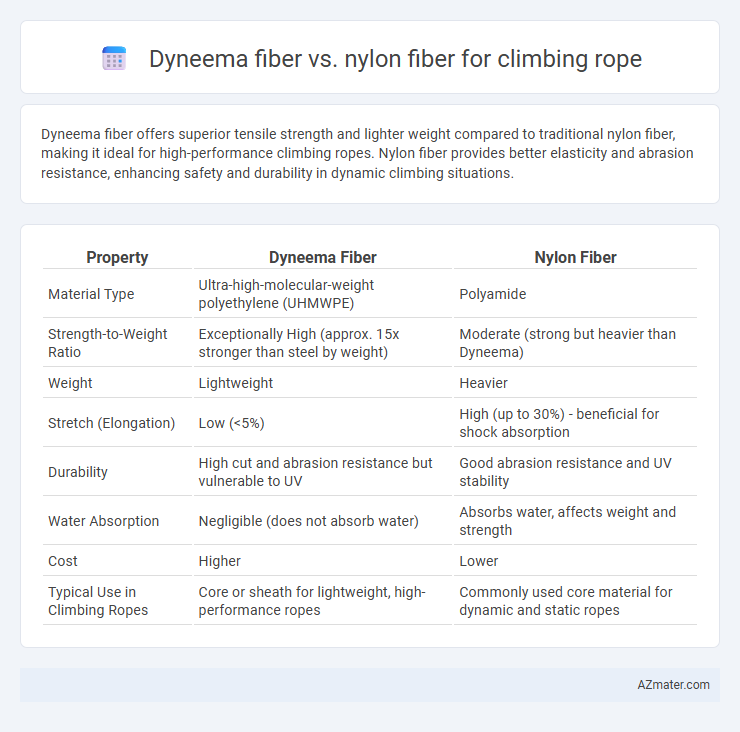Dyneema fiber offers superior tensile strength and lighter weight compared to traditional nylon fiber, making it ideal for high-performance climbing ropes. Nylon fiber provides better elasticity and abrasion resistance, enhancing safety and durability in dynamic climbing situations.
Table of Comparison
| Property | Dyneema Fiber | Nylon Fiber |
|---|---|---|
| Material Type | Ultra-high-molecular-weight polyethylene (UHMWPE) | Polyamide |
| Strength-to-Weight Ratio | Exceptionally High (approx. 15x stronger than steel by weight) | Moderate (strong but heavier than Dyneema) |
| Weight | Lightweight | Heavier |
| Stretch (Elongation) | Low (<5%) | High (up to 30%) - beneficial for shock absorption |
| Durability | High cut and abrasion resistance but vulnerable to UV | Good abrasion resistance and UV stability |
| Water Absorption | Negligible (does not absorb water) | Absorbs water, affects weight and strength |
| Cost | Higher | Lower |
| Typical Use in Climbing Ropes | Core or sheath for lightweight, high-performance ropes | Commonly used core material for dynamic and static ropes |
Introduction to Climbing Rope Materials
Climbing rope materials primarily consist of Dyneema and Nylon fibers, each offering distinct performance attributes crucial for climbers. Dyneema fibers provide exceptional strength-to-weight ratios and low stretch, enhancing dynamic response and reducing rope weight. Nylon fibers, widely used in traditional climbing ropes, deliver superior elasticity, durability, and abrasion resistance, crucial for absorbing falls and providing safety during climbs.
What is Dyneema Fiber?
Dyneema fiber is an ultra-high-molecular-weight polyethylene (UHMWPE) known for its exceptional strength-to-weight ratio, making it significantly stronger and lighter than traditional nylon fibers used in climbing ropes. This synthetic fiber offers superior abrasion resistance, low stretch, and excellent durability under extreme conditions, providing climbers with enhanced safety and performance. Compared to nylon, Dyneema's hydrophobic properties reduce water absorption, maintaining rope integrity in wet environments and extending the rope's overall lifespan.
What is Nylon Fiber?
Nylon fiber is a synthetic polymer widely used in climbing ropes due to its exceptional strength, elasticity, and abrasion resistance. Unlike Dyneema fiber, nylon offers superior shock absorption, which is crucial for safely catching falls during climbing activities. Its ability to stretch under load reduces impact forces, making nylon fiber a reliable and popular choice for dynamic climbing ropes.
Strength and Durability Comparison
Dyneema fiber offers superior tensile strength and is significantly lighter than nylon, making it highly efficient for climbing ropes requiring maximum load-bearing capacity. Nylon fiber, while heavier, provides excellent elasticity and abrasion resistance, enhancing rope durability under dynamic stress and rough surfaces. Choosing between Dyneema and Nylon depends on prioritizing either high strength-to-weight ratio or enhanced wear resistance for specific climbing conditions.
Weight and Flexibility Differences
Dyneema fiber, known for its ultra-high molecular weight polyethylene composition, offers significantly lower weight compared to nylon, making climbing ropes lighter and easier to carry during long ascents. In terms of flexibility, nylon fibers provide superior stretch and elasticity, which helps absorb dynamic forces and enhances shock absorption during falls, while Dyneema ropes are stiffer and less elastic, resulting in reduced energy absorption but improved handling in low-stretch applications. The choice between Dyneema and nylon fibers for climbing ropes depends on the prioritization of weight savings versus flexibility and impact force dissipation.
Water Absorption and Weather Resistance
Dyneema fiber exhibits exceptionally low water absorption, maintaining strength and flexibility even when wet, unlike Nylon fiber which absorbs significant moisture, leading to increased weight and reduced performance. Dyneema's superior weather resistance prevents degradation from UV exposure and harsh environmental conditions, ensuring longer rope lifespan compared to Nylon. Climbers benefit from Dyneema ropes' consistent handling and durability in wet or variable weather, critical for safety and reliability.
Safety Performance in Climbing Scenarios
Dyneema fiber exhibits superior tensile strength and lower elongation compared to nylon, enhancing safety by reducing stretch during dynamic climbing falls. Its high resistance to abrasion and moisture absorption ensures consistent performance under harsh environmental conditions, critical for maintaining rope integrity in climbing scenarios. Nylon fibers provide better energy absorption due to their elasticity but are more susceptible to wear and water retention, potentially compromising safety over time.
Longevity and Maintenance
Dyneema fiber offers superior longevity for climbing ropes due to its high resistance to abrasion, UV degradation, and moisture compared to nylon fiber, which tends to weaken faster under similar conditions. Maintenance requirements for Dyneema ropes are minimal as the fiber does not absorb water and resists dirt accumulation, whereas nylon ropes require regular drying and cleaning to prevent mold, mildew, and fiber deterioration. This enhanced durability and low-maintenance nature make Dyneema an optimal choice for climbers seeking long-lasting performance in varied environments.
Cost and Availability
Dyneema fiber, known for its high strength-to-weight ratio, is significantly more expensive than nylon fiber, which makes it less accessible for budget-conscious climbers. Nylon fiber dominates the climbing rope market due to its widespread availability, lower cost, and excellent elasticity that improves shock absorption during falls. While Dyneema offers superior durability and water resistance, its limited production and premium pricing restrict its use to specialized applications.
Choosing the Right Fiber for Your Climbing Needs
Dyneema fiber offers exceptional strength-to-weight ratio and superior resistance to abrasion and moisture, making it ideal for lightweight, high-performance climbing ropes. Nylon fiber provides greater elasticity and shock absorption, enhancing safety by reducing impact forces during falls. When selecting a climbing rope, prioritize Dyneema for durability and weight-conscious climbs, while nylon suits scenarios demanding flexibility and energy absorption.

Infographic: Dyneema fiber vs Nylon fiber for Climbing rope
 azmater.com
azmater.com